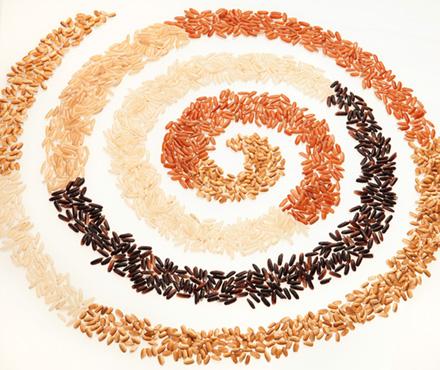New Research Re-envisions Worldwide Staple

White, light brown, brown, red, and purple/black rice.
ARS scientists improve nutrients and add value to rice crop.
Rice, already the primary staple for half the world’s population, is getting a makeover from a research team in New Orleans, LA. The results are a more healthful grain and many potential new products.
The team, based in the Agricultural Research Service’s Southern Regional Research Center (SRRC), is making rice a more valuable commodity by developing new technologies that capitalize on the grain’s natural health benefits.
“We’re interested in processing treatments that enhance resistant starch and other bioactive components,” said Stephen Boue, a research chemist with SRRC’s Food Processing and Sensory Quality Research unit. “We’re also using whole grain sprouts from rice to develop unique functional foods, like rice beverages and enhanced rice flour as a cooking ingredient.”
Bioactive compounds – such as lycopene, lignan, and tannin – may promote good health. Studies are underway to determine their role in the prevention of cancer, heart disease, and other diseases.
One such development is a rice variety that is more beneficial to human health. According to Boue, rice contains 76–78% starch. Cooked rice typically contains 1-2% starch that resists digestion, but the newer rice varieties have 8-10% resistant starch, or more. Resistant starch is not digested in the small intestine; rather, it passes through to the large intestine, where it ferments and produces beneficial metabolites.
“Resistant starch has many health benefits, like the prevention of diabetes, fat loss, better insulin resistance, and reduced risk of colorectal cancer,” Boue said.
Another new variety not only enhances human health, it’s good-looking, too.
“Red and purple whole grain rice offer U.S. consumers more colorful and healthy options to put on their plates,” Boue said. “They provide some of the same antioxidants as fruits, like grapes and blueberries. Additionally, the food industry can use these new rice varieties to make novel foods, particularly snack foods.”
Antioxidants help neutralize free radicals, which are naturally occurring molecules that form in the body. Free radicals are thought to play a role in a variety of diseases, including cancer, cardiovascular diseases, diabetes, Alzheimer’s and Parkinson’s diseases, cataracts, and age-related macular degeneration.
One of the new products, created by Ryan Ardoin, SRRC sensory scientist, is rice-based horchata, a sweet drink. It begins as a rice-milk, with flavors like cinnamon and vanilla added later. Horchata made from white rice is currently available at grocery stores, but Ardoin is re-creating the traditional drink using sprouted rice, which provides added health benefits. Another beverage he is developing is a rice version of iced tea made by cold-brewing purple rice bran.
“I’m excited about exposing consumers to the new colors, flavors, and products from rice and helping to change their perceptions about rice from ‘just a starch’ to ‘something healthy,’” Boue said. – by Scott Elliott, ARS Office of Communications
Also in our Mardi Gras series:

